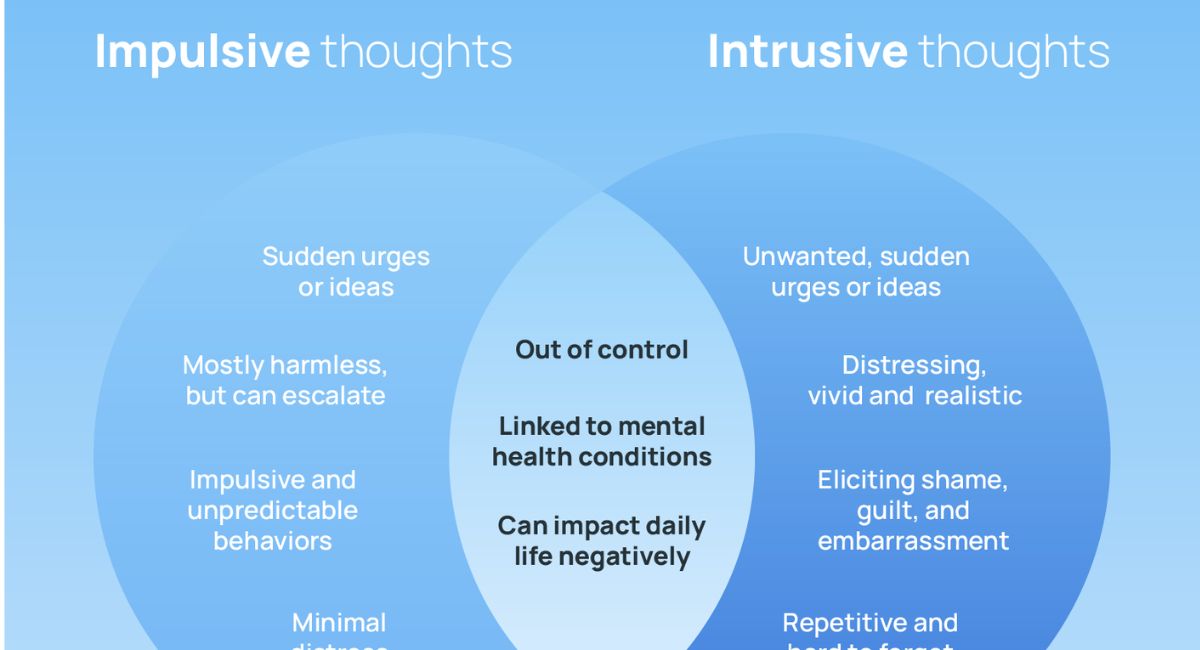Understanding the Nature of Human Thoughts
Have you ever caught yourself thinking something so strange or unsettling that you wondered, “Why did that even pop into my head?” Maybe it was an image that made you feel guilty, or an urge to do something you knew didn’t make sense. If so, you’re not alone. Many people struggle with the confusion of intrusive vs. impulsive thoughts, and it can be stressful not knowing what they mean or how to handle them.
That’s exactly what this blog will help you with. We’ll break down the real difference between intrusive and impulsive thoughts, explain why they show up, and share practical ways to manage them. By the end, you’ll have a clear understanding of both, plus helpful strategies to ease the frustration they often bring.

What Are Intrusive Thoughts?
At their core, intrusive thoughts are unwelcome mental images, sudden fears, or strange ideas that enter the mind without permission. They often clash with a person’s values, making them feel anxious or guilty. Intrusive thoughts meaning goes beyond ordinary worries; these thoughts can be severe enough to impact focus, sleep, and relationships. Researchers often link intrusive thoughts OCD, intrusive thoughts anxiety, and intrusive thoughts depression as common sources of distress in people across the United States.
Unlike normal day-to-day worries, intrusive thoughts are hard to dismiss. They become sticky and return again and again, leaving someone questioning their own character. It is important to remember that these distressing or taboo reflections do not define who someone is. Instead, they highlight the need for intrusive thoughts treatment, such as therapy or medication.
Common Examples of Intrusive Thoughts
Examples help reveal how intrusive thoughts work in real life. Many people experience violent intrusive thoughts, such as imagining hurting themselves or others. Some deal with sexual intrusive thoughts that feel inappropriate and out of character. Others may struggle with blasphemous thoughts that go against religious values. People often face self-doubt thoughts, such as constant worries about being unworthy or making mistakes. These thoughts can also involve harm or illness, leading to strong fear and unease.
These recurring and unwanted thoughts bring heavy emotional weight. They can make a person feel out of control and isolated, even though having them is far more common than most admit.
Categories of Intrusive Thoughts
Intrusive thoughts fall into recognizable groups. Some involve violent intrusive thoughts about self-harm or harming others. Others involve sexual intrusive thoughts that cause shame. Some focus on faith or morality, such as blasphemous thoughts. Another group involves health and danger, where people constantly fear illness or accidents. Finally, self-doubt thoughts can shake confidence and self-image.
Understanding these categories helps people see that they are not alone. Millions of Americans live with these psychological manifestations, especially those with OCD, PTSD, or anxiety. The presence of these thoughts often marks a larger issue within mental health intrusive thoughts.
What Are Impulsive Thoughts?
If intrusive thoughts feel like being trapped with recurring and unwanted thoughts, impulsive thoughts feel more like being pushed toward action. In impulsive thoughts psychology, these thoughts appear suddenly and create uncontrollable urges to do something right away. Unlike intrusive thoughts, which usually stay inside the mind, impulsive thoughts often show themselves through behavior.
For example, someone may suddenly decide to buy an expensive item without considering their budget. This is a clear case of impulsive decisions mental health professionals describe as acting on snap decisions without weighing outcomes. The key to understanding impulsive thoughts lies in their connection with triggers such as emotions, desires, or social influences.
Common Causes of Impulsive Thoughts
Impulsive thoughts causes range from environmental to emotional. Stress, frustration, and even excitement can set off an impulsive urge. Hormonal changes, neurological conditions, or exposure to risky environments can also play a role. In some cases, impulsive actions and regret follow because the decision was made without time to think.
Impulsive thoughts differ from intrusive vs obsessive thoughts because they tend to arise from a source of triggers for impulsive thoughts such as hunger, peer pressure, or emotional highs.
Examples of Impulsive Behaviors
Real-world impulsive behavior examples show how these thoughts move into action. Overspending, binge eating, reckless driving, or blurting out harmful words are all linked to impulsive thinking. Many Americans also recognize coping with impulsive urges in the context of social media challenges, late-night online shopping, or risky thrill-seeking activities. These may seem harmless at first but can lead to regret or even serious consequences.
Intrusive vs. Impulsive Thoughts: Key Differences

While both intrusive and impulsive thoughts feel overwhelming, they operate differently. Intrusive thoughts bring feelings of guilt or shame due to intrusive thoughts, while impulsive ones often leave people dealing with impulsive actions and regret. One remains mostly in the mind, the other often shows up in behavior.
A simple way to see the difference between intrusive and impulsive thoughts is through comparison.
| Aspect | Intrusive Thoughts | Impulsive Thoughts |
|---|---|---|
| Source of Trigger | Often random, linked to mental health conditions like anxiety, depression, PTSD, OCD | Tied to emotions, stress, or environment |
| Duration and Frequency of Intrusive Thoughts | Long-lasting and repetitive | Short-lived, situation-based |
| Level of Control over Thoughts | Difficult to stop, but usually not acted upon | Hard to resist, often acted upon immediately |
Source of Trigger
Intrusive thoughts often have no clear beginning, while impulsive thoughts appear due to external cues or strong emotions. Someone may suddenly fear harming a loved one (intrusive) while another might buy something expensive because it’s on sale (impulsive).
Duration and Frequency
Intrusive thoughts may last for weeks, months, or even years, resurfacing often. In contrast, impulsive thoughts tend to be brief. They pop up quickly and vanish after the behavior occurs.
Level of Control
Both thoughts feel powerful, but in different ways. With intrusive thoughts, a person may feel tormented by their mind. With impulsive thoughts, a person may feel pushed into quick action. Understanding these differences makes it easier to build coping strategies for intrusive thoughts and management strategies for impulsive thoughts.
Why Understanding the Difference Matters
Misunderstanding intrusive and impulsive thoughts can make people feel alone or ashamed. When someone believes their thoughts reflect their character, it can create unnecessary suffering. Recognizing that intrusive thoughts don’t define who you are, and that impulsive ones don’t have to control you, provides relief.
In the United States, many individuals confuse intrusive thoughts vs compulsions with impulsive urges. Knowing the difference not only helps in personal growth but also guides people to the right kind of support. It reduces stigma and encourages seeking professional help for thought disorders.
Causes Behind Intrusive and Impulsive Thoughts
Both intrusive and impulsive thoughts have complex origins. Genetics, stress, brain chemistry, and past trauma play significant roles. For some, intrusive thoughts and PTSD go hand in hand. Others may face impulsive tendencies due to ADHD or mood disorders.
Cultural and social factors also matter. Living in a high-stress environment, being influenced by peers, or having unresolved emotional pain can spark either intrusive or impulsive patterns. By learning the root cause, individuals can take meaningful steps toward healing through therapy and medication for intrusive vs impulsive thoughts.
Coping With Intrusive Thoughts
Dealing with intrusive thoughts requires patience and strategy. Many people benefit from mindfulness practices, journaling, and grounding exercises that help reduce the intensity of recurring and unwanted thoughts. Professionals often reassure patients that intrusive thoughts do not equal action.
Effective Treatments and Management
Intrusive thoughts treatment often includes Cognitive Behavioral Therapy (CBT) or Exposure and Response Prevention (ERP). These methods train the brain to manage anxiety around unwanted images and reduce their power. In severe cases, medication may also be part of the plan. For some, joining psychiatric clinical trials intrusive thoughts provides access to new therapies. This shows that effective coping strategies for intrusive thoughts exist, and no one has to face them alone.
Coping With Impulsive Thoughts
Impulsive thoughts need a different approach. The goal is to build space between the thought and the action. Simple techniques like pausing before acting, writing down urges, or reaching out to a trusted friend can reduce the risk of regretful choices.
Management Strategies and Self-Control Techniques
Experts recommend building routines that limit temptation. This can include budgeting apps for spending habits, setting reminders for healthy routines, or practicing mindfulness to handle coping with impulsive urges. These steps represent practical impulsive control strategies that allow individuals to live more balanced lives.
Similarities Between Intrusive and Impulsive Thoughts
Despite their differences, both intrusive and impulsive thoughts can be disruptive. They come suddenly, they may feel overwhelming, and they are both influenced by underlying mental health conditions like anxiety, depression, PTSD, OCD. Each can leave people questioning themselves or feeling ashamed.
The truth is, neither intrusive nor impulsive thoughts are rare. Millions of Americans experience them, and both require compassion, understanding, and—sometimes—professional support.
When to Seek Professional Help

It is important to know when these thoughts move beyond normal. If intrusive thoughts depression begins to affect relationships, or if impulsive actions cause ongoing regret, help is needed. Ignoring the problem can worsen it, while reaching out early can make treatment more effective.
Therapy Options
Therapists offer powerful tools to manage thoughts. Cognitive Behavioral Therapy, Dialectical Behavioral Therapy, and medication are common paths. These treatments form the backbone of therapy and medication for intrusive vs impulsive thoughts.
Online and In-Person Resources
For those living in the US, options are broad. Telehealth makes therapy accessible from home, while community health centers offer affordable in-person care. National hotlines are available for urgent support, and psychiatric clinical trials intrusive thoughts may provide new ways of healing. Seeking help is not weakness; it is strength. It means choosing to move forward and taking control over both intrusive and impulsive patterns.
Frequently Asked Questions (FAQs)
1. Are intrusive thoughts dangerous?
No. Intrusive thoughts are not dangerous because they don’t represent your true desires. The distress they cause comes from how different they are from your real self.
2. Can intrusive thoughts turn into impulsive actions?
Rarely. Intrusive thoughts usually trigger avoidance, not action. But if someone is struggling with impulse control disorders, the lines can blur — professional support helps here.
3. Do intrusive thoughts mean I have OCD?
Not necessarily. OCD involves repetitive intrusive thoughts paired with compulsions. Many people have intrusive thoughts without having OCD.
4. How can I stop impulsive spending?
Try delaying purchases by 24 hours, removing saved payment methods, or budgeting with accountability apps. Building awareness of triggers is the first step.
5. Which is worse: intrusive or impulsive thoughts?
Neither is “worse.” Both can cause problems in different ways. Intrusive thoughts harm peace of mind, while impulsive thoughts can harm decision-making. Both are manageable with the right strategies.
6. Can diet, sleep, or exercise affect these thoughts?
Yes. Poor sleep increases impulsivity and intrusive thought frequency. Exercise and balanced nutrition support emotional regulation and cognitive clarity.
7. Should I tell someone about my intrusive thoughts?
If they’re distressing, sharing them with a trusted therapist or friend can reduce shame. Remember, therapists hear these all the time — you’re not alone.

